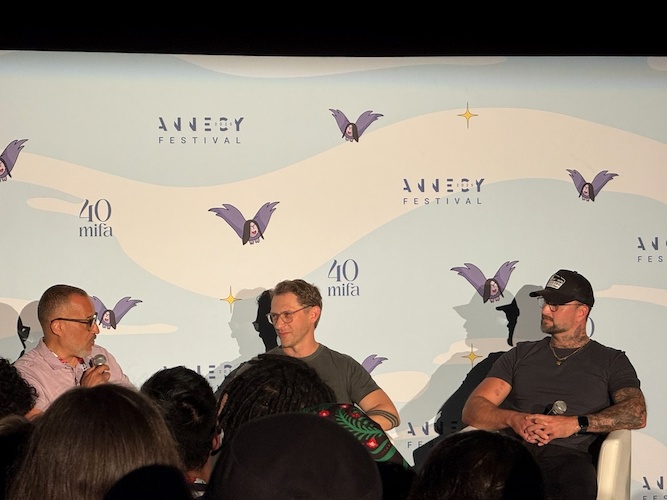Making "Predator: Killer of Killers" - How The Third Floor Rebooted a Sci-Fi Icon in Record Time
At the 2025 Annecy Festival, audiences got a behind-the-scenes look at Predator: Killer of Killers — the stylized animated feature now streaming on Hulu. In a panel presented by Epic Games, The Third Floor’s Josh Wassung and Dustin Warnock detailed how they reimagined the iconic sci-fi franchise using real-time technology, a cinematic production approach, and a lightning-fast 18-month timeline. What followed was a deep dive into how the film was made — and how it signals a bold new direction for animated filmmaking.
Before The Third Floor became one of the world’s premier visualization studios, its founders were part of George Lucas’ team on Star Wars: Episode III — literally working in the attic above the art department at Skywalker Ranch. Whenever Lucas needed something fixed in previs, he’d send it "up to the third floor." The nickname stuck, and when the team decided to launch their own company, the name became a badge of honor.
For years, The Third Floor specialized in previsualization and postvisualization on blockbuster franchises — The Mandalorian, Lord of the Rings, Star Wars, and more — but Predator: Killer of Killers marks a turning point. It’s the studio’s first full animated feature, fusing live-action sensibilities with stylized concept art in a real-time pipeline powered by Unreal Engine.
Co-director Josh Wassung had worked with director Dan Trachtenberg on Prey, and even as that film was in production, the idea of a stylized animated Predator project began to percolate. When Prey proved successful, the timing was finally right.
By late 2022, The Third Floor began development on a proof-of-concept test. A skeletal team delivered a visceral, stylized action short in just under three months — from late October to January. It became the foundation of their pitch to 20th Century Studios: a Predator film rendered as "moving concept art." The pitch included a stylized on-twos animation aesthetic, exaggerated Predator motion, and 2D effects that pushed the visual identity far beyond realism.
The project received the green light in phases. Full preproduction — previs, assets, art direction — officially began in September 2023. By December, the team had assembled the entire film in reels. The final approved cut, locked at just under 80 minutes, was delivered only 18 months later, in February 2025. That aggressive schedule was made possible by rethinking traditional animation workflows. “We built the entire film up on reels in four months," Wassung shared, “then iterated like we would on a live-action movie."
Instead of a waterfall production pipeline, departments worked in parallel. Story, concept art, layout, and animation all evolved simultaneously, informed by screenings every few weeks. Even the production designers — Joel Chang and Amy Carter (daughter of Forrest Gump and Jurassic Park production designer Rick Carter) — approached their work like a live-action film, creating researched historical backdrops and letting lighting and mood inform the emotional arc of the film.
With roots in both games and animation, Animation Director Dustin Warnock joined The Third Floor to help build their real-time animation pipeline. Tools like Unreal Engine and their proprietary compositor, Hummingbird, enabled total control over lighting, rim effects, toon lines, and painterly textures, allowing the film to visually feel like a living painting. This was especially critical for establishing the film’s “illustrated realism" — a hybrid style that took inspiration from concept art, storyboards, comics, and traditional 2D animation, rather than chasing photorealism. “We weren’t trying to make it look like live action," said Warnock. “We were trying to make it look like the concept art for live action."
Each of the film’s chapters was assigned to a dedicated team. One of the most challenging sequences — the “brother fight" between a ninja and samurai — was used to define the film’s stylistic range. Layout was informed by stunt consultants and samurai historians, whose movements were captured, referenced, and refined in animation. Shot structure mirrored a live-action fight scene, structured with acts, reversals, and emotional beats.
In total, the team delivered 1,683 shots, peaking with animation throughput in summer 2024 and locking final shots by February 2025. While game-engine rendering offered speed, constraints like the 80-minute runtime came down to creative focus, not technical limits. “The hardest part wasn’t the volume; It was deciding what story to tell within that time," Wassung noted. Key to the project’s success was a philosophy of “creative efficiency": collapsing departmental silos, empowering artists at every stage, and using real-time tools not just for speed, but to elevate storytelling.
With the pipeline now built and battle-tested, The Third Floor is eager to push further. The lessons of Predator: Killer of Killers — rapid iteration, cinematic stylization, real-time rendering — hint at a new animation frontier, where live-action storytelling blends seamlessly with animated worlds.
Predator: Killer of Killers is now streaming on Hulu. Click here for more coverage from Annecy.




